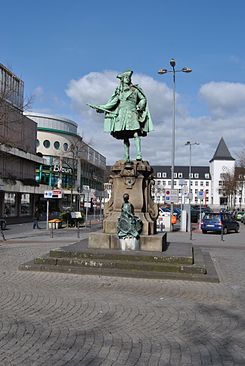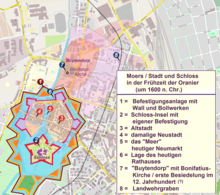Neumarkt (Moers)
| Neumarkt | |
|---|---|
| Place in Moers | |
 Memorial Friedrich I (2012) |
|
| Basic data | |
| place | Moers |
| District | Old town |
| Created | 1664 |
| Confluent streets | Neustraße, Meerstraße, Steinstraße, Unterwallstraße |
| Buildings | City church , Peschkenhaus , Braun fashion house, town hall |
| use | |
| User groups | Foot traffic ; Car / bicycle traffic on the west and east sides |
| Space design | Pedestrian area on the southern edge, side lanes, parking lot |
The Moerser Neumarkt is one of the big squares in the Moers city center with the fort square . It has a long trapezoidal floor plan and is bordered by commercial buildings on the sides. The Peschkenhaus is located on the southern side, above Neustraße , opposite the town church . The old town hall is located on the north side of the square.
The area of today's Neumarkt used to be part of an arm of the Rhine , on the banks of which a settlement was built over 900 years ago, from which today's city of Moers emerged.
Almost directly to the south is the fort square, which is surrounded by restaurants, the old district office, the White House and the Terheydenhaus, near Moers Castle .
history


In the Middle Ages, the “sea”, the Moersbach dammed into a wide moat, which separated the old town and the new town, was located at the site of the Neumarkt . In addition to the moats, a wall and a gate tower at the end of Steinstrasse protected the old town , the wall and towers the new town. A bridge connected the two parts of the city.
With the construction of the new fortification by Moritz von Oranien (1567-1625) from 1601 to 1620, who combined the castle and the city in a star-shaped wall and moat, the sea lost its importance. It was partially backfilled between 1614 and 1639.
In 1664 the central part of the moat between Neustraße and Niederstraße was vaulted. This was the beginning of the new market. The Neustraße now reached up to the “Meertor”, the tallest and only remaining of the medieval city gates .
With a clock and bell from 1617 (today in the Grafschafter Museum in Moers Castle ), it became the tower of the new town hall on Steinstrasse, which was built around 1610 and it was the city's landmark until it was demolished in 1907.
The building of the new city scales from 1674 stood on Neustraße (the scales are now in the Grafschafter Museum in Moers Castle ). Around 1700 the new market was called Lindenplatz and the gardens on the north side were enlarged in the 19th century.
In 1902, the citizens donated a monument to Friedrich I (1657–1713) to mark the 200th anniversary of their membership in Prussia . During his reign, Moers became Prussian. On this occasion, Kaiser Wilhelm II visited Moers. The statue of the ruler was designed by the Düsseldorf sculptor Heinrich Baucke .
In 1913, the square, which looked quite rural towards the wall, was to be upgraded in terms of urban planning: with a town hall at the north end and adjacent commercial and residential buildings. The First World War prevented the realization, only in 1954 a new town hall, today called the old town hall, was inaugurated.
From 1914 to 1963 the route of the tram lines Moers – Homberg and Krefeld – Moers ran directly past Neumarkt and until 1968 the trolleybus lines : Rheinhausen - Vluyn , Ruhrort - Kamp and Ruhrort - Ossenberg .
The Neumarkt was a traffic junction until the redesign of the new and the Steinstraße in a pedestrian zone and the relocation of the lines and car traffic via the “Königlichen Hof” and the newly built “Neuen Wall” .
Events
Various events take place on and around Neumarkt. A weekly market takes place there twice a week (Wednesdays and Saturdays).
The Moerser Kirmes , which takes place every year on the 1st weekend in September, which stretches from Friedrich-Ebert-Platz over Homberger Straße and Steinstraße and to Kastellplatz, also uses Neumarkt.
literature
- Wolf Strache : Moers. (= The beautiful books. Volume 29 and German cities. Volume 32). DSB Verlag, Stuttgart 1965, DNB 453426514 .
- Birgit and Rainer Schiffler: The architectural and art monuments. In: The Wesel district. Konrad Theiss Verlag, Stuttgart 1983, ISBN 3-8062-0288-5 .
- Gabriele M. Knoll: The Lower Rhine; Landscape, history and culture on the lower Rhine. Du Mont Buchverlag, Cologne 1990, ISBN 3-7701-2283-6 .
- Margreth Wensky, Andrea Rönz (ed.): Moers the history of the city from the early days to the present. Volume 2: From Prussian times to the present. Böhlau Verlag, Cologne / Weimar / Vienna 2000, ISBN 3-412-04600-0 .
- Margreth Wensky (Red.): History stations Moers. History Stations Working Group Moers, Moers 2014, ISBN 978-3-00-045683-1 .
- Thorsten Kamp: From the "sea" to the market. In: Kreis Wesel yearbook 2011. Verlagshaus Wohlfahrt, Duisburg 2010, ISBN 978-3-87463-477-9 .
- Kristin Dohmen, Giesbert Knopp (Red.): Moers. Castle - cultural center. Festschrift for the 100th anniversary of the Grafschafter Museum and History Association Moers eV; Werner publishing company. Worms 2004, ISBN 3-88462-205-6 .
Web links
- moers.de History Station 13: Neumarkt
- gmgv-moers.de, Neumarkt
- google.de, maps Place Neumarkt, 47441 Moers
Individual evidence
- ↑ Fashion Center Braun
- ↑ History station 18: Town Hall
- ↑ Drehscheibe-online.de a very interesting picture; Ludger K; November 3, 2010
- ↑ derwesten.de historic tram; Harry Seelhoff; October 6, 2014
- ↑ District of Wesel
- ↑ Weekly and farmers markets
- ↑ moers-stadtportal.de, weekly market downtown
- ↑ Moerser Kirmes
Coordinates: 51 ° 27 ′ 6 ″ N , 6 ° 37 ′ 31 ″ E